Alan Bean
| Alan Bean | |
|---|---|
 | |
| NASA Astronaut | |
| Nationality | American |
| Born |
Alan LaVern Bean March 15, 1932 Wheeler, Texas, U.S. |
| Died |
May 26, 2018 (aged 86) Houston, Texas, U.S. |
Other occupation | Naval aviator, test pilot |
| UT Austin, B.S. 1955 | |
| Rank |
|
Time in space | 69d 15h 45min |
| Selection | 1963 NASA Group 3 |
Total EVAs | 3 |
Total EVA time | 10 hours 26 minutes[1] |
| Missions | Apollo 12, Skylab 3 |
Mission insignia |
|
| Retirement | June 1981 |
| Awards |
|
Alan LaVern Bean (March 15, 1932 – May 26, 2018) was an American naval officer and naval aviator, aeronautical engineer, test pilot, and NASA astronaut; he was the fourth person to walk on the Moon. He was selected to become an astronaut by NASA in 1963 as part of Astronaut Group 3.
He made his first flight into space aboard Apollo 12, the second manned mission to land on the Moon, at age 37 in November 1969. He made his second and final flight into space on the Skylab 3 mission in 1973, the second manned mission to the Skylab space station. After retiring from the United States Navy in 1975 and NASA in 1981, he pursued his interest in painting, depicting various space-related scenes and documenting his own experiences in space as well as that of his fellow Apollo program astronauts. He was the last living crew member of Apollo 12.
Biography
Early life and education
Bean was born March 15, 1932, in Wheeler, the seat of Wheeler County in the northeastern Texas Panhandle. He considered Fort Worth his hometown.[2] He was of Scottish descent. As a boy, he lived in Minden, the seat of Webster Parish in northwestern Louisiana, where his father worked for the U.S. Soil Conservation Service. Bean was a Boy Scout and he earned the rank of First Class.[3] He graduated from R. L. Paschal High School in Fort Worth, Texas, in 1950.[4]
Bean received a bachelor of science degree in aeronautical engineering from the University of Texas at Austin in 1955.[5]
Military service
He was commissioned a U.S. Navy ensign through the Naval Reserve Officers Training Corps at UT Austin, and attended flight training.[4] After completing flight training, he was assigned to a Attack Squadron 44 (VA-44) at NAS Jacksonville, Florida, from 1956 to 1960, flying the F9F Cougar and A4D Skyhawk. After a four-year tour of duty,[6] he attended the U.S. Naval Test Pilot School (USNTPS) at NAS Patuxent River, Maryland, where his instructor was his future Apollo 12 Commander, Pete Conrad.[2] He then flew as a test pilot on several types of naval aircraft. Following his assignment at USNTPS, he was assigned to Navy Attack Squadron VA-172 at NAS Cecil Field, Florida, flying the A-4 Skyhawk from 1962 to 1963, during which time he was selected as a NASA astronaut.[7]
Bean logged more than 7,145 hours flying time, including 4,890 hours in jet aircraft.[8]
NASA career
Bean was selected by NASA as part of Astronaut Group 3 in 1963 (after not being selected for Astronaut Group 2 the previous year).[9] He was selected to be the backup command pilot for Gemini 10, but was unsuccessful in securing an early Apollo flight assignment. He was placed in the Apollo Applications Program in the interim. In that capacity, he was the first astronaut to dive in the Neutral Buoyancy Simulator and a champion of the process for astronaut training.[10] When fellow astronaut Clifton Williams was killed in an air crash, a space was opened for Bean on the backup crew for Apollo 9. Apollo 12 Commander Conrad, who had instructed Bean at the Naval Flight Test School years before, personally requested Bean to replace Williams.[7]
Apollo program
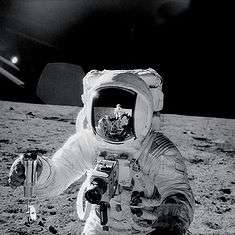
Bean was the lunar module pilot on Apollo 12, the second lunar landing. In November 1969, Bean and Pete Conrad landed on the moon's Ocean of Storms—after a flight of 250,000 miles and a launch that included a harrowing lightning strike. He was the astronaut who executed John Aaron's "Flight, try SCE to 'Aux'" instruction to restore telemetry after the spacecraft was struck by lightning 36 seconds after launch, thus salvaging the mission. They explored the lunar surface, deployed several lunar surface experiments, and installed the first nuclear power generator station on the Moon to provide the power source. Dick Gordon remained in lunar orbit, photographing landing sites for future missions.[8]
_Pete_Conrad%2C_Dick_Gordon%2C_and_Al_Bean_pose_with_the_Apollo_12_Saturn_V.jpg)
Bean had planned on using a self-timer for his Hasselblad camera to take a photograph of both Pete Conrad and himself while on the lunar surface near the Surveyor III spacecraft. He was hoping to record a good photo, and also to confuse the mission scientists as to how the photo could have been taken. However, neither Conrad nor he could locate the timer in the tool carrier tote bag while at the Surveyor III site, thus lost the opportunity. He did not locate the self-timer until the end of the EVA when it was too late to use — when he threw it as hard as he could.[11] His paintings of what this photo would have looked like (titled "The Fabulous Photo We Never Took") and one of his fruitless search for the timer ("Our Little Secret") are included in his collection of Apollo paintings.[12][13]
Bean's suit is on display in the National Air and Space Museum.[14]
Skylab
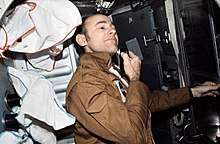
Bean was also the spacecraft commander of Skylab 3, the second manned mission to Skylab, from July 29 to September 25, 1973. With him on the 59-day, 24.4 million mile world-record-setting flight were scientist-astronaut Owen Garriott and Marine Corps Colonel Jack R. Lousma.[8] During the mission, Bean tested a prototype of the Manned Maneuvering Unit and performed one spacewalk outside the Skylab. The crew of Skylab 3 accomplished 150% of its mission goals.[8]
Post-NASA career
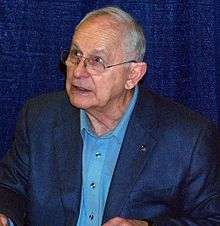
On his next assignment, Bean was backup spacecraft commander of the United States flight crew for the joint American-Russian Apollo-Soyuz Test Project.[8]
Bean retired from the Navy in October 1975 as a captain, and continued as head of the Astronaut Candidate Operations and Training Group within the Astronaut Office in a civilian capacity.[8]
Bean logged 1,671 hours and 45 minutes in space, of which 10 hours and 26 minutes were spent in EVAs on the Moon and in Earth orbit.[8]
Painting
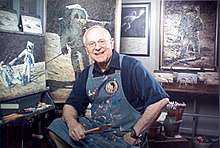
Bean resigned from NASA in June 1981 to devote his time to painting. He said his decision was based on the fact that, in his 18 years as an astronaut, he was fortunate enough to visit worlds and see sights no artist's eye, past or present, has ever viewed firsthand and he hoped to express these experiences through his art.[4]
As a painter, Bean wanted to add color to the Moon. "I had to figure out a way to add color to the Moon without ruining it," he remarked. In his paintings, the lunar landscape is not a monotonous gray, but shades of various colors. "If I were a scientist painting the Moon, I would paint it gray. I'm an artist, so I can add colors to the Moon", said Bean.[15]
Bean's paintings include Lunar Grand Prix and Rock and Roll on the Ocean of Storms, and he used real moon dust in his paintings.[16] When he began painting, he realized that keepsake patches from his space suit were dirty with moon dust. He added tiny pieces of the patches to his paintings, which made them unique. He also used a hammer, used to pound the flagpole into the lunar surface, and a bronzed moon boot to texture his paintings.[17]
In July 2009, for the 40th anniversary of the Apollo 11 moon landing, Bean exhibited his lunar paintings at the Smithsonian Institution’s National Air and Space Museum in Washington.[18]
But I'm the only one who can paint the moon, because I'm the only one who knows whether that's right or not.
— Bean describing his Moon painting capability[4]
Personal life and death
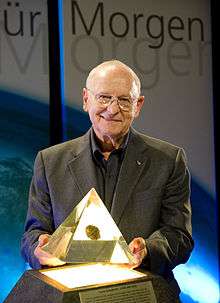
Bean took a little piece of MacBean tartan to the Moon.[19]
Bean died on May 26, 2018, in Houston, Texas, at the age of 86.[20] His death followed the sudden onset of illness two weeks before while he was in Fort Wayne, Indiana.[21] At the time of his death, Bean was married to his second wife, Leslie. He had a son, Clay, and a daughter, Amy Sue, both from his first marriage.[21]
Legacy
- Rear Admiral William S. Parsons Award for Scientific and Technical Progress[8]
- Godfrey L. Cabot Award for 1970[8]
- National Academy of Television Arts and Sciences Trustees Award[8]
- Texas Press Associations Man of the Year Award for 1969[8]
- City of Chicago Gold Medal[8]
- Federation Aeronautique Internationale Yuri Gagarin Gold Medal for 1973[8]
- V. M. Komarov Diploma for 1973[8]
- AAS Flight Achievement Award for 1974[8]
Bean received the Navy Astronaut Wings, the Navy Distinguished Service Medal (twice), and the NASA Distinguished Service Medal (twice).[8]
Bean was inducted into the International Space Hall of Fame in 1983,[4] the U.S. Astronaut Hall of Fame in 1997,[22] the International Air & Space Hall of Fame in 2010,[23] and the National Aviation Hall of Fame for 2010.[24] He was also a fellow of the American Astronautical Society and a member of the Society of Experimental Test Pilots.[8]
Bean received the University of Texas Distinguished Alumnus Award in 1970 and the Distinguished Engineering Graduate Award.[25] The 1973 Robert J. Collier Trophy was awarded to NASA and the Skylab crew.[26] Bean was awarded an Honorary Doctorate of Science from Texas Wesleyan College in 1972, and was presented an Honorary Doctorate of Engineering Science degree from the University of Akron (Ohio) in 1974.[8] In 1975, President Ford presented Skylab commander Gerald Carr with the Dr. Robert H. Goddard Memorial Trophy at a White House ceremony, on behalf of all Skylab astronauts (including Bean).[27] Bean was a co-recipient of AIAA's Octave Chanute Award for 1975, along with fellow Skylab 3 astronauts Jack Lousma and Owen Garriott.[28]
In media
In the 1998 HBO miniseries From the Earth to the Moon, Bean was portrayed by Dave Foley.[29] Swedish indie pop artist Stina Nordenstam has a song called "The Return of Alan Bean" on her 1991 debut album Memories of a Color.[30] British indie rock band Hefner released a single called "Alan Bean" in 2001, writing from the perspective of Bean during Apollo 12.[31]
Books
- My Life As An Astronaut (1989) ISBN 978-0671674250
- Apollo: An Eyewitness Account (with Andrew Chaikin) (1998) ISBN 978-0867130508
- Into the Sunlit Splendor: The Aviation Art of William S. Phillips (with Ann Cooper, Charles S. Cooper and Wilson Hurley) (2005) ISBN 978-0867130935
- Mission Control, This is Apollo: The Story of the First Voyages to the Moon (with Andrew Chaikin) (2009) ISBN 978-0670011568
- Painting Apollo: First Artist on Another World (2009) ISBN 978-1588342645
Bean's in-flight Skylab diary is featured in Homesteading Space: the Skylab Story, a history of the Skylab program co-authored by fellow astronauts Dr. Joseph Kerwin and Dr. Owen Garriott and writer David Hitt, published in 2008.[32]
See also
References
- ↑ Joachim Becker. "Alan Bean - EVA experience".
- 1 2 "Men of the Apollo XII Crew". The Kokomo Tribune. Kokomo, Indiana. November 25, 1969. p. 29.
- ↑ "Scouting and Space Exploration". Archived from the original on March 4, 2016.
- 1 2 3 4 5 "Piloted the lunar module on Apollo 12, the second lunar landing mission". New Mexico Museum of Space History. Retrieved May 28, 2018.
- ↑ Gecker, Jocelyn (May 26, 2018). "Apollo moonwalker, artist Alan Bean dies at age 86 in Houston". FOX 7.
- ↑ The Lunar Hall of Fame: Alan Bean Archived March 25, 2009, at the Wayback Machine.
- 1 2 "Alan Bean Oral History". NASA. Retrieved November 11, 2017.
- 1 2 3 4 5 6 7 8 9 10 11 12 13 14 15 16 17 18 "Astronaut Bio: Alan Bean".
- ↑ Chaikin, Andrew. A Man on the Moon. Penguin Books Ltd. ISBN 978-0-14-024146-4.
- ↑ von Braun, Wernher (2010), Buckbee, Ed, ed., The Rocket Man: Wernher von Braun: The Man Who Took America to the Moon: His Weekly Notes: 1961-1969 (DVD), Steward & Wise Music Publishing, p. 1966-07 p. 79, ISBN 978-1-935001-27-0
- ↑ "NASA - Ocean Rendezvous". Nasa.gov. November 19, 1969. Archived from the original on December 15, 2010. Retrieved December 14, 2010.
- ↑ "Our Little Secret". Alanbeangallery.com. Retrieved December 14, 2010.
- ↑ Bean, Alan and Chaikin, Andrew. "Apollo: An Eyewitness Account", The Greenwich Workshop Press; First Edition (January 10, 1998). ISBN 0-86713-050-4
- ↑ "Historic Spacecraft - Space Suit Photos".
- ↑ "Alan Bean". International Museum of Art. Retrieved December 24, 2017.
- ↑ "Conversations: Astronaut-Turned-Moon Artist Alan Bean". Washington Post. July 19, 2009. Retrieved December 24, 2017.
- ↑ Bean, Alan. "Message from Alan Bean". Alan Bean: first artist on another world. Retrieved January 23, 2017.
- ↑ Dunham, Will (May 26, 2018). "Alan Bean, moon-walking U.S. astronaut turned painter, dies in Houston". Reuters. Retrieved May 26, 2018.
- ↑ "Clan MacBean Arrives On The Moon". alanbeangallery.com. Archived from the original on July 20, 2012. Retrieved December 2, 2007.
- ↑ "Alan Bean, moon-walking astronaut and artist, dies aged 86". BBC News. May 27, 2018. Retrieved May 27, 2018.
- 1 2 "Family Release Regarding the Passing of Apollo, Skylab Astronaut Alan Bean". NASA. May 26, 2018. Retrieved May 26, 2018.
- ↑ "Alan Bean". Astronaut Scholarship Foundation. Retrieved December 24, 2017.
- ↑ Sprekelmeyer, Linda, editor. These We Honor: The International Aerospace Hall of Fame. Donning Co. Publishers, 2006. ISBN 978-1-57864-397-4.
- ↑ "Bean, Alan L." The National Aviation Hall of Fame. Retrieved December 24, 2017.
- ↑ "Distinguished Alumnus Award". Texas Exes. Retrieved May 28, 2018.
- ↑ "Collier Trophy at Test Range". The Orlando Sentinel. Orlando, Florida. October 3, 1974. p. 21 – via Newspapers.com.
- ↑ "Ford Praises Astronauts, Space Program". Daily Press. Newport News, Virginia. UPI. April 12, 1975. p. 23 – via Newspapers.com.
- ↑ "Chanute Flight Test Award Recipients". AIAA. Retrieved May 28, 2018.
- ↑ "From the Earth to the Moon, Full Cast and Crew". IMDb. Retrieved December 5, 2017.
- ↑ Alan Bean at AllMusic
- ↑ Porter, Christopher (September 15, 2009). "Hefner, 'Alan Bean'". The Washington Post. Retrieved May 26, 2018.
- ↑ Plaxco, Jim (September 16, 2009). "Book Review: Homesteading Space". National Space Society. Retrieved May 26, 2018.
Bibliography
- Jones, Eric (1995). "TV Troubles". Retrieved July 16, 2007.
External links
| Wikimedia Commons has media related to Alan Bean. |
| Wikiquote has quotations related to: Alan Bean |
- Limited Edition Art: Prints and Canvases http://www.greenwichworkshop.com/bean/
- Astronautix biography of Alan Bean
- Alan Bean on IMDb
- Bean at Encyclopedia of Science
- Official publisher website for Homesteading Space
